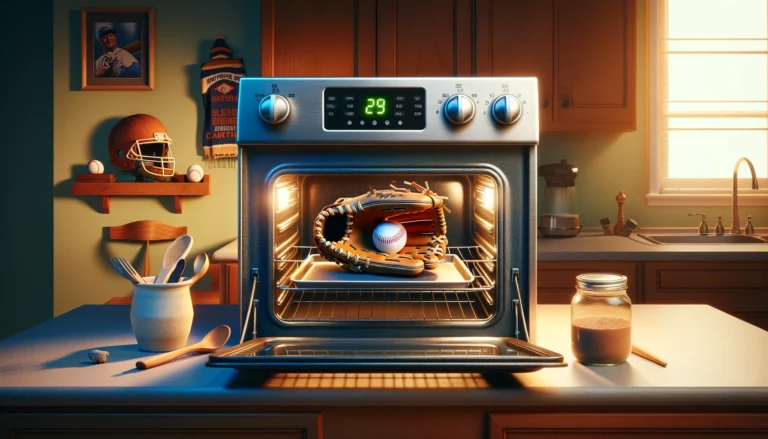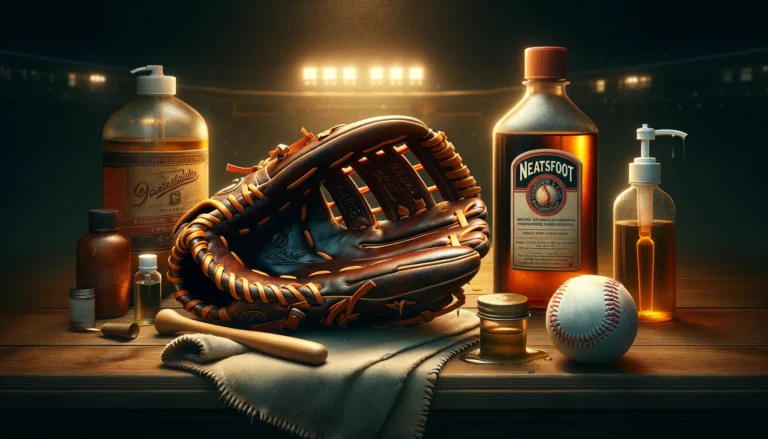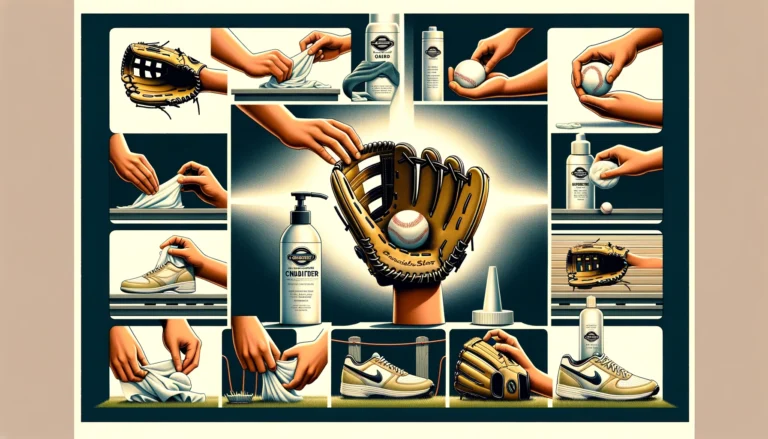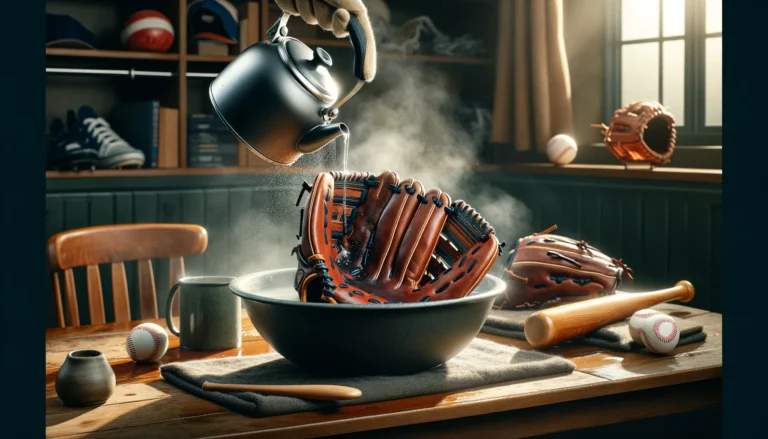What Hand Do You Wear a Baseball Glove On?
As a baseball enthusiast, one of the most basic questions you may have is: Which hand should you wear a baseball glove on?
This simple query can leave many players, especially beginners, confused and struggling to find the right fit. Wearing a glove on the wrong hand can lead to frustration, poor performance, and even possible injuries.
In this article, we’ll explore the details of baseball glove placement, giving you a clear and definitive answer to this age-old question.
By the end, you’ll have the confidence to take the field with your glove on the correct hand, ready to make those game-winning plays.
Key Takeaways
- Glove orientation is based on hand dominance; players should wear their gloves on the non-dominant hand to free up their dominant hand for throwing.
- Determining hand dominance is essential for both catching and batting, as it influences glove selection and batting grip.
- Choosing the right glove size is critical for control and performance, with age-based recommendations available to assist in selection.
- GloveMate enhances fielding and batting by providing extra comfort, filling gaps for better bat grip, and reducing the sting from ball impact.
- Incorporating GloveMate into your routine requires proper attachment and positioning to maintain glove flexibility and effectiveness during transitions between fielding and batting.
Understanding Glove Orientation and Hand Dominance

The Basics of Right-Hand Throw vs. Left-Hand Throw
When it comes to choosing a baseball glove, understanding the difference between right-hand throw (RHT) and left-hand throw (LHT) is crucial.
For those who throw with their right hand, a left-hand throw glove is needed, which is worn on one finger of the left hand.
Conversely, left-hand throwers should opt for a right-hand throw glove to wear on their right hand. This distinction is essential for the left handed players’ comfort and performance on the field.
To determine which glove orientation suits you best, consider the following points:
- If you throw with your right hand, select a Left Hand Throw glove.
- If you throw with your left hand, choose a Right Hand Throw glove.
- Always try on gloves to ensure a proper fit and feel before making a purchase.
Remember, the correct glove orientation not only enhances your fielding abilities but also complements your batting grip, as it allows for a natural and secure hold on the bat.
When shopping for a glove, look for the hand orientation specification to make an informed decision. You may read also How to Clean Baseball Batting Gloves
Assessing Your Dominant Hand for Catching
Determining your dominant hand for catching is crucial for selecting the correct glove orientation. The opposite hand that you use to throw the ball is your glove hand.
For instance, if you throw with your right hand, you will wear the glove on the index finger slot on your left hand, and vice versa. This may seem counterintuitive, but it allows your dominant hand to be free for throwing.
To assess which hand is dominant, you can perform simple tests. One such test is to eat with a fork or spoon using the index finger of both hands.
The hand that feels more comfortable and natural for this task is your left handed and likely your dominant hand.
Additionally, try throwing the ground ball and catching a ball with one hand and then the other; the hand that performs these actions with greater ease is probably your dominant hand.
Here are some steps to help you identify your catching hand:
- Eat with a fork or spoon using both hands.
- Throw and catch a ball with each hand.
- Observe which hand you naturally use for tasks like writing or brushing your teeth.
- Consider which hand feels more coordinated and stronger during physical activities.
Remember, while hand dominance is a good starting point, comfort, and control dominant left hand are also key factors in choosing your catching hand.
The Role of Hand Dominance in Batting Grip
Understanding the relationship between hand dominance and batting grip is crucial for players looking to maximize their performance at the plate.
Hand dominance significantly influences how a player grips and swings the bat, affecting both comfort and control during batting.
For many players, the dominant hand provides the stability and power behind the swing, while the non-dominant hand guides the direction and finesse.
It’s important to experiment with different grips to find what works best for your style and strength.
Here are some considerations when assessing your batting grip:
- The position of your hands on the bat can affect bat speed and control.
- The tightness of your grip can impact your swing’s fluidity and the bat’s responsiveness.
- Adjusting your grip based on pitch location and type can improve your hitting accuracy.
Players often overlook the subtle ways that hand dominance can affect batting, but paying attention to these details can lead to significant improvements in hitting performance.
Read Also: How Do You Get a Golden Glove in Baseball
Choosing the Right Glove Size for Optimal Performance

Age-Based Glove Size Recommendations
Selecting the appropriate glove size is crucial for young baseball players to ensure comfort, control, and the development of proper fielding techniques.
Baseball glove size recommendations are typically based on age, providing a general guideline for parents and coaches.
For children under the age of 8, a 10-inch glove is often recommended. This size allows for easier control and helps build confidence as they learn the fundamentals of the game.
As children grow and their skills develop, the glove size should increase accordingly. For those 9 years and older, an 11.5-inch glove is usually suitable, offering a better fit and more versatility on the field.
It’s important to note that gloves come in different orientations for right handed thrower first-hand throw (RHT) or left-hand throw (LHT), and they can be used for both baseball and softball.
Always ensure to select the correct hand orientation for your child’s dominant catching hand.
Factors Influencing Glove Size Selection
Selecting the right glove size is crucial for player comfort and performance. Hand orientation is a primary factor; gloves are designed as either right-hand throw or left-hand throw.
This means that a right-hand throw glove is worn on the other left handed glove hand, and vice versa. It’s essential to choose a glove that corresponds with your throwing hand.
Another consideration is the player’s age and size. For instance, a 10″ glove is typically recommended for kids 8 years and under, while an 11.5″ glove suits kids 9 years and older.
Here’s a quick reference:
- 10″ Glove: Recommended for kids 8 years and under.
- 11.5″ Glove: Recommended for kids 9 years and up.
Lastly, the type of material and any add-ons can influence the glove’s fit and feel. Leather and memory foam, for example, are common materials that offer durability and comfort.
Add-ons like GloveMate can enhance grip and reduce discomfort, but it’s important to consider how they might affect the glove’s size and fit.
Adjusting Glove Fit for Comfort and Control
Ensuring your baseball glove fits properly is crucial for both comfort and control on the field. Adjusting the fit of your glove can make a significant difference in your performance.
Here are some steps to achieve the perfect fit:
- Identify any areas of discomfort in your current glove fit and note where adjustments are needed.
- Use a glove mallet or a small hammer to tap lightly on the laces to tighten them, enhancing the glove’s conformity to your hand.
- Test the glove’s fit by playing catch and making fielding movements to ensure the adjustments have improved comfort and control.
Remember, to properly wear a well-fitted glove can help prevent errors and increase your confidence in the diamond.
If you’re experiencing persistent discomfort or lack of control, consider consulting with a professional or trying a different glove size or style.
Read Also: Is There a Difference Between Softball and Baseball Gloves
Conclusion
In conclusion, determining the correct hand for donning your baseball glove is crucial for both comfort and performance on the field.
Whether you’re a seasoned player or just starting, understanding the difference between right-hand throw (RHT) and left-hand throw (LHT) baseball gloves well, and how they correspond to your dominant hand, is essential.
The Glovemate product testimonials highlight the importance of proper hand protection and grip, which can significantly enhance your game.
Remember to consider factors such as age, glove size, and specific needs when selecting your glove.
Ultimately, the right glove fit will not only help prevent the sting of catching fly balls but also improve your overall experience in the sport.
Frequently Asked Questions
What Hand Do You Wear a Baseball Glove On?
Typically, you wear your glove on your non-dominant hand. For example, if you’re right-handed, you’ll wear the glove on the dominant side of your left hand, and vice versa. This allows your dominant hand to be free for throwing.
What is GloveMate and how does it help with catching?
GloveMate is a protective device that you attach to your glove hand to cushion the impact of the ball and reduce discomfort. It’s made from leather and memory foam and is designed to fit without hindering glove flexibility or causing a trampoline effect.
Can GloveMate be used for both fielding and batting?
Yes, users have reported that GloveMate is effective for both fielding and batting. It can be attached to different fingers to help with bat grip problems and is suitable for use while fielding to stop the sting of the ball on the middle finger.
What size glove should I buy for my child?
The 10″ glove is recommended for kids 8 years and under, while the 11.5″ glove is recommended for kids 9 years and up. Make sure to choose the correct hand orientation for your child, based on their dominant hand.
How does GloveMate impact batting grip?
GloveMate can be attached to either the middle or ring finger to fill the space between the middle finger slot itself and the bat, solving bat grip problems and allowing for a more comfortable and secure hold.
Is GloveMate suitable for all ages and positions?
Yes, GloveMate is recommended for all ages and can be used for all positions in baseball and softball. It’s designed by a professional baseball player to provide hand protection without affecting performance.
You may read also:







